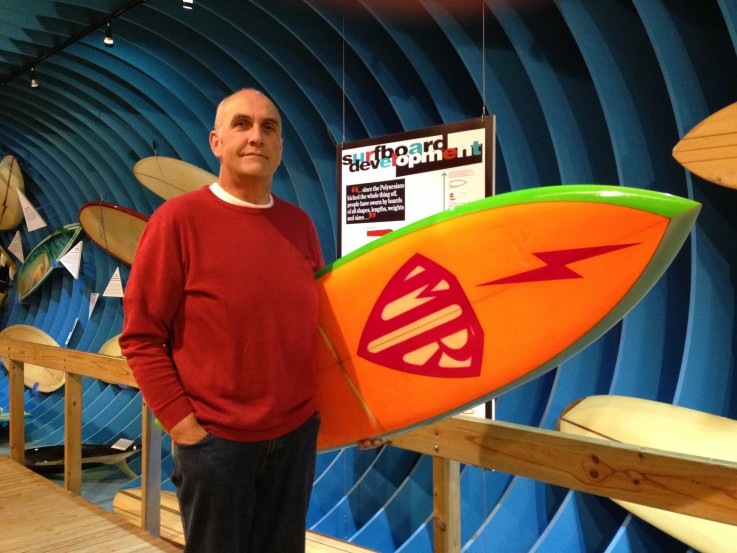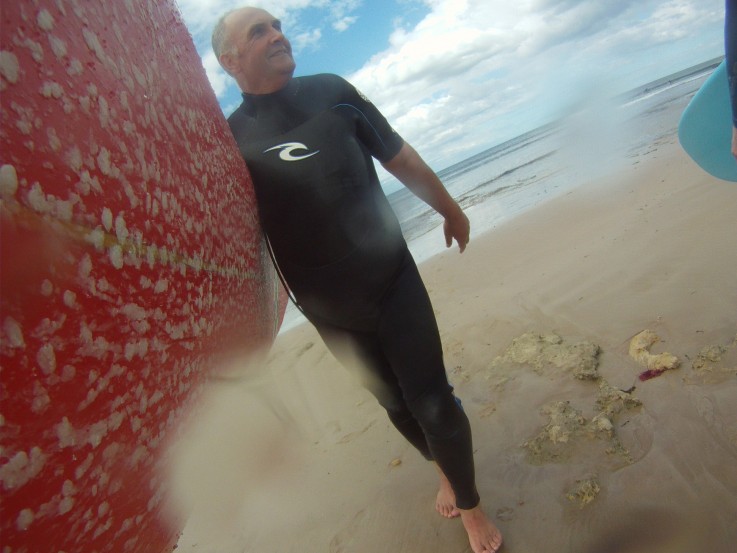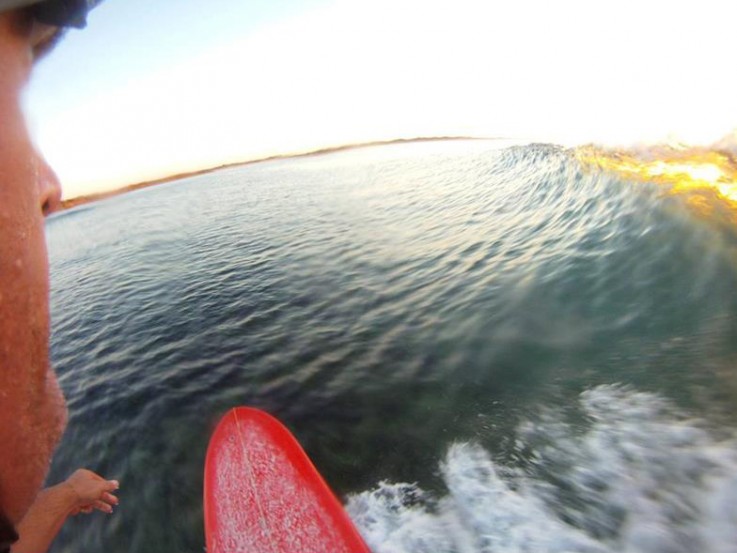Craig Baird - Surf World Museum
Where and when did you first start surfing?
My introduction to surfing was pretty organic in the sense that nobody really taught me. We used to camp every year on the spit of land between Barwon Heads and Ocean Grove, I used to have a little foamie and I would paddle around in the river then started dragging it across the road and started surfing Raffs when I was about 10 years old. It was just a matter of watching what other people were doing and copying them. I got a fiberglass board for my 15th birthday and I started surfing closeouts at Ocean Grove main beach. I remember 2 things about surfing at that time, getting worked at Thirteenth, and the first time I rode a reef break.
What is it that you love about surfing?
I know that it’s different things for different people, but for me surfing is an intensely personal experience. I love the feeling of being immersed in nature. I hate crowds, but I just love getting out there, catching waves and having fun. My favourite spot is about half an hour walk from where I live, so even if there’s no petrol or if everything disappeared I’d still be able to charge down the beach.
Have you done much surf travel?
No, I went to the Maldives for my honeymoon in 1985 and foolishly didn’t take a board. At that time, surfing was basically unknown over there. We were staying on the island next to Jails and I remember watching this big sweeping right-hander wrapping around the island and thinking Wow! I got my hands on a sailboard and stripped all the sails and gear off and thought about paddling out. I’m pretty sure I would of ended up splattered on the reef if I tried taking it out. I’ve promised myself I’ll go back to surf it one day.
Have you had much education/ early work experience?
The best jobs I’ve had I haven’t applied for, I’ve just been in the right place at the right time/ I remember the day school finished I went into town to register for the dole. Spot the optimist here! And on the way back home the guy at the local surf shop asked me if I wanted to work there. So straight out of school I was managing a surf shop. It was nuts, every single moment of every single day was about surfing. I’d try and squeeze in before and after work surfs then during the day all I would talk about would be surfboards, wetsuits, shorts and stuff. It was Piping Hot’s surf shop before Piping Hot was even a brand. I did that for 2 years and started to think that maybe there was more to life. It was just such a full on thing. Even when I was outside of work I would have people coming up and asking me how their boards are going etc. There was no off switch. It was just surfing 24/7. I knew there was more out there I needed to experience so I went and did some laboring and waiting work but all that did was make me appreciate working in surf.
What other roles have you had within the surf industry?
In the mid 80’s I was air-brushing t-shirts, sold a few through Rip Curl, then ended up spraying boards for them for over 25 years. That kind of dovetailed with what I’m doing here. I got to experience every step and all the elements of making a board. Every single board in the Surf World museum I can tell you what it is how it works and what is involved in its design. So it kind of set me up to be a content specialist in regards to surfboards. It also allowed me to meet and become familiar with many of the individuals who make up the surfing world. I had guys like Midget Farrelly talking to me about the quality of masking tape and things like that. It was a pretty cool thing to be doing. I ended up working for about 5 different factories and here at the museum, so as one job would kind of fade out I’d settle into the next one.
How did you get the job at the Museum?
Same kind of thing really. I was at a mate’s house one day and one of the guys from Surfing Australia was there. He suggested I come and speak to the guys here. I got to speak to Steve Robertson who is now the ASP Media Manager and he gave me the O.K. I started doing a couple of days a week then slowly progressed to full time.
What is your role here?
I’m the Curator of the museum which basically means I’m the organizer and manager of all the museum content and displays. Coming from that artistic background and having a grounding in the Surf Industry, it was a great combination and perfect background for this role.
What does your job involve on a day to day basis?
It’s a pretty diverse role in that there is a lot of very different activities involved. We have a huge amount of surfing material we use to tell the history of surfing and we have a lot of different relationships to maintain. The local community donates a lot of the material here, so we act as almost a community museum that reflects the history of the place. We’re involved with the Surf Industry from the key individuals who help shape it and organisations like Surfing Australia down to the people who visit us every day. So there are a lot of different levels of relationships to preserve.
How big of an operation is the Surf World Museum?
It’s the world’s largest surfing museum, but we have a small dedicated team. That small team working directly within the museum are involved in a lot of different aspects of museum operations, exhibitions, education tours, managing the collection, research and much more. We all pitch in. We know everything in here but people who visit don’t, so it’s important that we are able to explain, interpret or talk about everything that we have on display.
What is your favourite part of the job?
The creative aspect mainly. That is the most attractive part of my job. It freaks me out sometimes how much history is crammed in my head. It’s a complimentary thing for me as it takes all the experience and skills that I have developed and putting me in an environment where they are useful. My younger brother told me a while ago that I am in the perfect place doing the perfect job, and I think he’s pretty spot on.
Is there anything that you don’t like about job?
It’s definitely has its challenges. Being involved in a creative process which is run through a bureaucratic system is definitely the hardest part. I work for the Surf Coast Shire and they are a government organization. There is a gulf between the political/corporate culture in an organization like that and the surfing culture we are trying to reflect. Surfing is such a freewheeling open ended thing, while the bureaucratic processes and framework we have to operate within are quite rigid and unyielding. They are two very different beasts.
Do you have a favourite piece in the museum?
For me there are two boards in here that are important to me and my history of which in a weird loop have ended up back in my life. They are both boards that belonged to Mark Richards. The first is his King Kong board that I first had in my hands 30 years ago. He used to sell all his boards out the back of his shop in Newcastle. It was $170 I remember and I was set on buying it when I was up there on a holiday. Funnily enough while I was out for a surf after deciding to buy it our car got broken into and all my money got stolen meaning King Kong slipped through my fingers. I wrote MR a letter about all sorts of things and mentioned that story to him and a couple of weeks later he sent me a message telling me that King Kong had been found up a tree without a nose and tail and they had fixed it up, and now it’s in here. The other one is an Aipa board in here with a flame job on it. I remember seeing it years ago in a magazine. The cut out rail and the swallow tail with this amazing hot rod inspired flame job. When I first started in the surf shop the first thing I did was buy an airbrush and paint a flame job. From then on flames were my favourite board sprays, I did hundreds of them in the surfboard factory, and years later the inspiration for all of that ends up in here on a wall. Every time I walk past it I smile.
Do you see yourself continuing in this role well into the future?
I rack up 20 years at the Museum in August. Part of me says that is way too long to stay in one job, but I remember when I first started working in the surfboard factory I had only planned on being there for a short period of time. When I was a kid I just assumed that all the old shapers were dead due to chemicals and the environment of surfboard factories. One of the great parts of this job is that I’ve got to meet some of those legendary shapers and so many of them are fit, healthy and still shaping well into their old age. I think surfing may have something to do with that. But yeah, 20 years is a long time to do anything but if you are surrounded by people who are enthusiastic and share a love of surfing it makes a huge difference. So who knows how much longer I will be doing this. I still love it.
Where can we find you online?
| Web: | www.surfworld.com.au |
| Facebook: | www.facebook.com/SWMTorquay |
| Youtube: | www.youtube.com/user/surfworldtv |
Posted by: Troy Roennfeldt, on May 22, 2014
Categories: Interviews
Latest Posts
Craig Sims - White Horses & Surfing Life Publisher
Luke Kennedy - Editor of Tracks Magazine
Simon ‘Swilly’ Williams - Surf Photographer
Jarra Campbell - the Bondi Alchemist
Greg Gordon - Owner of CR Surf
Shayne Nienaber - Surf Photographer
Alexa Hohenberg - Owner of Still Stoked
Christine Deveney - TapaReef Owner & Creator
Russell Ord - Surf Photographer
Richard Kotch - Surf Photographer
Categories
Interviews
Articles
Videos
Press Releases
Quiz
Archive
December 2018
November 2018
October 2018
September 2018
August 2018
July 2018
June 2018
May 2018
April 2018
March 2018
February 2018
January 2018
November 2017
January 2017
December 2016
November 2016
October 2016
September 2016
August 2016
July 2016
June 2016
May 2016
April 2016
March 2016
February 2016
January 2016
December 2015
November 2015
October 2015
September 2015
August 2015
July 2015
June 2015
May 2015
April 2015
March 2015
February 2015
January 2015
December 2014
November 2014
October 2014
September 2014
August 2014
July 2014
June 2014
May 2014
April 2014
March 2014
February 2014
January 2014
December 2013
November 2013
October 2013
September 2013
August 2013
July 2013
June 2013
May 2013
April 2013
March 2013











